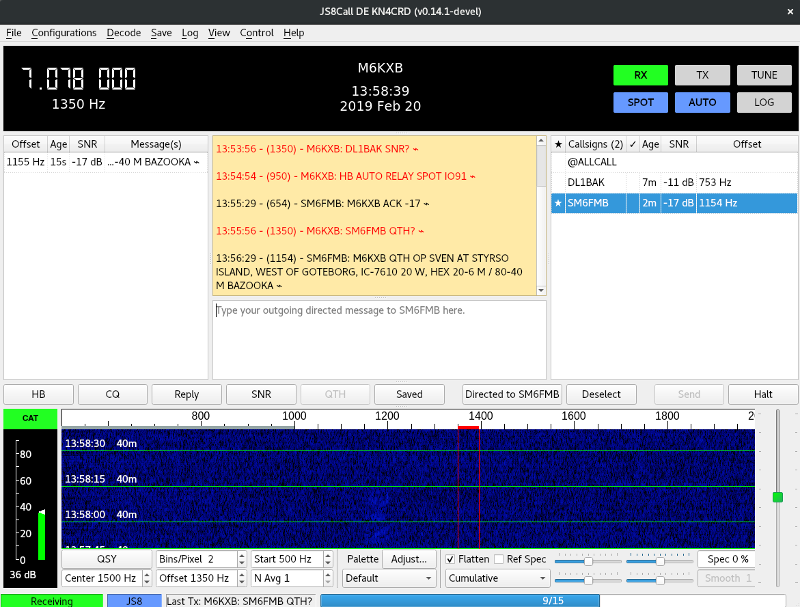[This page was converted from the Gemini version
at gemini://gemini.ctrl-c.club/~lars_the_bear/js8.gmi]
Since about 2018, the FT8 mode has completely taken over the world of digital amateur radio communication. A look at the PSK Reporter website today showed a World map of FT8 contacts that was very much like the map of all contacts. There was a smattering of PSK31, which was hailed a few of years as the next big thing. There was also a little FT4, which is the cut-down (as if that's possible) version of FT8. Almost all other modes -- nothing. Or, at least, as good as nothing.
PSK ReporterIt isn't hard to understand why this situation has arisen -- as we have progressed into the increasingly gloomy and intractable part of the sunspot cycle, the modes of radio communication have become more and more focused on weak-signal operation. FT8 isn't the mode that is most tolerant of weak signals, but it's the most tolerant of any mode that requires less than a minute to complete a trivial conversational exchange. Slower modes such as JT65 seem to have died off along with everything else. The problem with FT8 is that it's really only good for a semi-automated exchange of trivial details. A typical FT8 'conversation' amounts to an exchange of call-signs, signal reports, and locations. To be fair, many conversations in amateur radio don't go much beyond this, but it would be nice to be able to have a real conversation, albeit a slow one.
This is what PSK31 and its variants were supposed to offer. After conditions got worse and even PSK31 became ineffective, it was what Olivia was supposed to offer. Now that even Olivia is only marginally productive, where does that leave us?
Don't get me wrong -- FT8 is very useful. It's a great way to check the performance of your radio equipment, and to learn about band conditions and propagation. And, in conditions like those we are currently experiencing, it might be the only way to prevent cobwebs growing over your radio.
Still, wouldn't it be nice if you could actually converse with FT8?
This is where JS8 (a.k.a js8call, previously FT8Call) comes in. JS8 uses the same low-level protocol as FT8, and is therefore equally tolerant of weak signals. However, it extends FT8 to add message framing and signalling. Although it operates at speeds that make the Victorian trans-Atlantic telegraph look like broadband, it does actually work.
At the time of writing, the js8call application is the only software that supports JS8, and it is highly experimental. js8call is a derivative of the standard FT8 application, WSJT-X, and has many of the same user interface features. It is available for Mac and Windows, and for Linux, although for Linux you'll probably have to build it from source for now (I did).
The main user interface looks like this:

js8call user interface
There aren't many people using JS8 yet -- the right-hand part of the display shows the two(!) other callsigns that are operating within reception range from my location (London, UK). The asterisk alongside SM6FMB indicates that two-way communication has been established.
js8call can be used in several different ways. First, it can be used for a simple exchange of signal reports, just like WSJT-X. You can direct a "What is my SNR?" message at any other known station, and it will respond in its next transmit cycle. Or you can just send a "heartbeat" request (previously called a "beacon") and then all other stations are supposed to respond if they hear you.
Second, it can be used for automated exchanges of common information -- the sort of things that amateur radio operators might discuss routinely. You can pre-program your responses to questions like "What is your QTH?" and the software will respond on your behalf with a location indicator, even if you are not present.
Third, and most interestingly, you can carry out a free-form conversation. This can begin with a traditional 'CQ' transmission, or be directed at a specific station. It's generally not a good idea to send more than a sentence a time -- even that will probably take more than a minute to transmit, and the signal could fade in that time. The response from SM6FMB, about his location and equipment, took about a minute to receive.
Although it is a step in the right direction, there are a number of problems with JS8 as it is presently implemented.
In a sense, I can't help thinking that JS8 is what FT8 should always have been, which makes it particularly disappointing that JS8 and its parent are incompatible. Neither will even decode the other's messages, let alone transmit them. Reading the various forum discussions, I can't help thinking that there's not much love lost between the two camps, which is kind of sad. There's aren't that many people interested in amateur radio these days -- hardly any under 40 -- and the prevailing poor operating conditions do little to encourage interest. It does the amateur radio community no credit that groups with similar protocols have no interest in communicating.
[ Last updated Sun 21 Mar 17:30:40 GMT 2021 ]